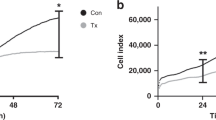Abstract
Objective
Effective treatments for preeclampsia are currently unavailable. As endothelial progenitor cell-transplantation may improve ischemia, it is an important undertaking to study the role of endothelial progenitor cells for improving the symptom of preeclampsia.
Method
Physiological and pathological changes in foetal rats and pregnant rats were monitored. Endothelial progenitor cells were isolated from the peripheral blood of normal rats and labelled by DiI. Endothelial progenitor cells were transplanted into the placenta of preeclampsia-like rats. Fluorescence microscopy was used to observe the differentiation of transplanted endothelial progenitor cells. Western blotting was used to observe the expression of nestin, an index of brain hypoxia in foetal rats.
Result
The rats suffered from abdominal aortic constriction and NG-nitro-l-arginine methyl ester injection (group F). The proteinuria and blood pressure of pregnant rats in group F increased on the 13th day of pregnancy. The proteinuria and blood pressure of group F was higher than in other groups of rats. The weight of foetal rats and foetal heads significantly decreased in group F compared with other groups. Typical pathological changes of preeclampsia were observed in the placental tissue of group F. In preeclampsia-like rats, transplantation of endothelial progenitor cells led to an increase in placenta angiogenesis. The expression of nestin weakened in endothelial progenitor cell-transplanted rats compared with the non-transplantation group. After EPCs transplantation, physiological parameters in the preeclampsia-like rats were significantly decreased.
Conclusion
Endothelial progenitor cells transplantation could improve preeclampsia-like symptom in rats and endothelial progenitor cell-transplantation relieves intrauterine hypoxia in brain tissues of foetal rats to a certain extent.




Similar content being viewed by others
References
Report of the National High Blood Pressure Education (2000) Program Working Group on High Blood Pressure in Pregnancy. Am J Obstet Gynecol 183:S1–S22
Sibai BM (2003) Diagnosis and management of gestational hypertension and preeclampsia. Obstet Gynecol 102:181–192
Ness RB, Roberts JM (1996) Heterogeneous causes constituting the single syndrome of preeclampsia: a hypothesis and its implications. Am J Obstet Gynecol 175:1365–1370
Zampetaki A, Kirton JP, Xu Q (2008) Vascular repair by endothelial progenitor cells. Cardiovasc Res 78:413–421
Asahara T, Murohara T, Sullivan A, Silver M, van der Zee R, Li T, Witzenbichler B, Schatteman G, Isner JM (1997) Isolation of putative progenitor endothelial cells for angiogenesis. Science 275:964–967
Hill JM, Zalos G, Halcox JP, Schenke WH, Waclawiw MA, Quyyumi AA, Finkel T (2003) Circulating endothelial progenitor cells, vascular function, and cardiovascular risk. N Engl J Med 348:593–600
Hauschka SD, Konigsberg IR (1966) The influence of collagen on the development of muscle clones. Proc Natl Acad Sci USA 55:119–126
Kalka C, Masuda H, Takahashi T, Kalka-Moll WM, Silver M, Kearney M, Li T, Isner JM, Asahara T (2000) Transplantation of ex vivo expanded endothelial progenitor cells for therapeutic neovascularization. Proc Natl Acad Sci USA 97:3422–3427
Nusken KD, Dotsch J, Rauh M, Rascher W, Schneider H (2008) Uteroplacental insufficiency after bilateral uterine artery ligation in the rat: impact on postnatal glucose and lipid metabolism and evidence for metabolic programming of the offspring by sham operation. Endocrinology 149:1056–1063
Tate MD, Deng YM, Jones JE, Anderson GP, Brooks AG, Reading PC (2009) Neutrophils ameliorate lung injury and the development of severe disease during influenza infection. J Immunol 183:7441–7450
Hwang HS, Cho NH, Maeng YS, Kang MH, Park YW, Kim YH (2007) Differential expression of nestin in normal and pre-eclamptic human placentas. Acta Obstet Gynecol Scand 86:909–914
Raijmakers MT, Peters WH, Steegers EA, Poston L (2004) NAD(P)H oxidase associated superoxide production in human placenta from normotensive and pre-eclamptic women. Placenta 25(Suppl A):S85–S89
Kanayama N, Tsujimura R, She L, Maehara K, Terao T (1997) Cold-induced stress stimulates the sympathetic nervous system, causing hypertension and proteinuria in rats. J Hypertens 15:383–389
Granger JP, LaMarca BB, Cockrell K, Sedeek M, Balzi C, Chandler D, Bennett W (2006) Reduced uterine perfusion pressure (RUPP) model for studying cardiovascular-renal dysfunction in response to placental ischemia. Methods Mol Med 122:383–392
Yallampalli C, Garfield RE (1993) Inhibition of nitric oxide synthesis in rats during pregnancy produces signs similar to those of preeclampsia. Am J Obstet Gynecol 169:1316–1320
Chambers JC, Fusi L, Malik IS, Haskard DO, De Swiet M, Kooner JS (2001) Association of maternal endothelial dysfunction with preeclampsia. JAMA 285:1607–1612
de Oliveira LG, Karumanchi A, Sass N (2010) Preeclampsia: oxidative stress, inflammation and endothelial dysfunction. Rev Bras Ginecol Obstet 32:609–616
Maslov AY, Barone TA, Plunkett RJ, Pruitt SC (2004) Neural stem cell detection, characterization, and age-related changes in the subventricular zone of mice. J Neurosci 24:1726–1733
Lendahl U, Zimmerman LB, McKay RD (1990) CNS stem cells express a new class of intermediate filament protein. Cell 60:585–595
Rehman J, Li J, Orschell CM, March KL (2003) Peripheral blood “endothelial progenitor cells” are derived from monocyte/macrophages and secrete angiogenic growth factors. Circulation 107:1164–1169
Acknowledgments
This project was supported by a grant from the National Nature Science Foundation of China (No.30600679).
Conflict of interest
The authors declare that they have no conflict of interest.
Author information
Authors and Affiliations
Corresponding author
Rights and permissions
About this article
Cite this article
Zhu, J., Cheng, X., Wang, Q. et al. Transplantation of endothelial progenitor cells for improving placental perfusion in preeclamptic rats. Arch Gynecol Obstet 291, 1113–1119 (2015). https://doi.org/10.1007/s00404-014-3522-z
Received:
Accepted:
Published:
Issue Date:
DOI: https://doi.org/10.1007/s00404-014-3522-z




